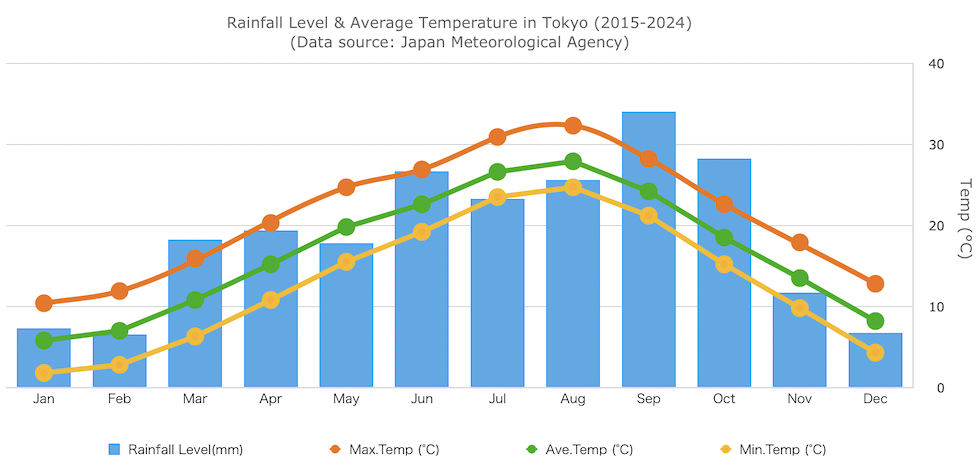Tokyo Climate & Weather: Monthly Averages & Seasonal Tips

Tokyo experiences distinct seasonal variations, but in recent years, spring and autumn seem to be shorter. Summers are hot and humid, while winters can be dry and cold. From July to October, typhoon season occurs, bringing sudden heavy rain and strong winds.
Climate in Tokyo
Tokyo tends to have relatively more rainy days, with increased rainfall from March to October. The rainy season lasts from early June to mid-July, and then the peak of typhoon activity occurs from July to October. During this period, sudden downpours and storms are more likely, so it's a good idea to check the weather forecast and be prepared for changing conditions.

Rainfall Level, Average Temperature, Humidity in Tokyo (2015-2024)
| Jan | Feb | Mar | Apr | May | Jun | Jul | Aug | Sep | Oct | Nov | Dec | |
|---|---|---|---|---|---|---|---|---|---|---|---|---|
| Rainfall Level (mm) | 54.8 | 49.0 | 136.8 | 145.3 | 133.7 | 199.9 | 174.7 | 191.8 | 255.3 | 212.0 | 87.9 | 50.8 |
| Max.Temp (°C) | 10.4 | 11.9 | 15.9 | 20.3 | 24.7 | 26.9 | 30.9 | 32.3 | 28.2 | 22.6 | 17.9 | 12.8 |
| Ave.Temp (°C) | 5.8 | 7.0 | 10.8 | 15.2 | 19.8 | 22.6 | 26.6 | 27.9 | 24.2 | 18.5 | 13.5 | 8.2 |
| Min.Temp (°C) | 1.8 | 2.8 | 6.3 | 10.8 | 15.5 | 19.2 | 23.5 | 24.7 | 21.2 | 15.2 | 8.8 | 4.3 |
| Humidity (%) | 54.8 | 55.3 | 62.0 | 66.8 | 70.3 | 77.9 | 80.5 | 78.8 | 81.6 | 74.6 | 68.8 | 59.3 |
(Data source: Japan Meteorological Agency)
In recent years, summer temperatures have been much higher than the average, with intense heat and temperatures exceeding 35°C due to climate change and the urban heat island effect. As a result, it’s nearly impossible to get through the day without air conditioning.
Seasonal Clothing (Tokyo)
Spring (Mar. - May.): This period is typically mild and comfortable, but some days can still feel chilly, so a light jacket or sweater is advisable.
Summer (Jun. - Aug.): Summer is very hot and humid, so light clothing is appropriate. However, July and August can be especially scorching and humid, so it’s important to take proper precautions.
Autumn (Sep. - Nov.): Similar to spring, but temperatures can start to cool down, so a light jacket or long sleeves may be needed.
Winter (Dec. - Feb.): Winter is usually dry and cold, with temperatures occasionally reaching near 0°C. A warm coat, wool suit, and sweater are essential. Snow is rare, and even when it does fall, it rarely accumulates in Tokyo.
Overall, Tokyo has a relatively mild climate with distinct seasons, but it’s important to be prepared for the intense summer heat and humidity. Winter can be cold, but snowfall is uncommon, so the focus should be on staying warm.
Surviving the Weather in Tokyo: Some Tricks & Tips
Tokyo is a large city, and most people get around using public transportation, bicycles, or on foot. Because of this, changes in the weather can affect travel. It's important to be as prepared as possible for such situations. For example, check the weather forecast for rain, and if extreme heat is predicted, take measures to prevent heatstroke, avoid outdoor exercise, and take breaks as needed.
■ Precipitation:
Always check the weather forecast before you head out, and carry an umbrella if rain is expected. Nowadays, there are very small foldable umbrellas available. Sudden rain showers are common in Tokyo, so being prepared is essential. If you find yourself caught in the rain without an umbrella, you can always buy one at a nearby convenience store.
■ Heat:
Summer in Tokyo can be extremely hot, and the urban heat island effect is especially noticeable. Days with temperatures over 35°C are becoming more frequent, making it difficult to get by without air conditioning. Be sure to use air conditioning indoors and take precautions against heatstroke, even while sleeping.
■ Take advantage of Cool Biz:
If your office follows the "Cool Biz" dress code, you can wear lighter, more comfortable clothing such as polo shirts and chinos instead of a suit, making it easier to stay cool while working.
* What is Cool Biz?
Cool Biz is an initiative promoted by the Japanese government, encouraging office workers to dress in a more casual, comfortable manner during the summer to reduce air conditioning use. It recommends wearing lighter clothing, such as polo shirts and chinos, instead of suits and ties.
Seasons in Japan

Recently, the distinct change of seasons has become less pronounced, but Japan still experiences the four traditional seasons. Summer temperatures typically reach around 30°C, while winter temperatures often drop to around 0°C. Humidity is high during the summer and early fall, then dries out in the winter. However, rainfall is heaviest in the summer and autumn, particularly during the rainy season and due to the influence of typhoons.
Weather in Tokyo During Spring

The temperatures are generally comfortable, ranging from cool to warm, with relatively few rainy days. Cherry blossoms reach full bloom, and joining a hanami (flower viewing) party to celebrate the season is a delightful experience.
It’s best to dress in layers—one or two should be enough to keep warm during the morning chill while allowing for adjustments as temperatures rise throughout the day.
Be aware that Japanese cedar pollen fills the air from February to April, which may cause allergies for some.
>> Hay Fever (Kafunsho) in Japan
Weather in Tokyo During Summer

Summer in Tokyo can be divided into two distinct phases.
Rainy Season

The rainy season typically lasts for three to four weeks in June, bringing continuous rain almost every day. While there are occasional breaks of sunlight, expect damp conditions and cooler temperatures. Carrying an umbrella and wearing waterproof shoes is highly recommended. A raincoat and layered clothing will help you stay comfortable, as the weather can shift unexpectedly when the sun briefly appears through the clouds.
>> Fighting Humidity and Mold During Japan’s Rainy Season
Summer Proper
By late June, the rainy season gives way to intense summer heat. From then until mid to late August, temperatures rise significantly, making it essential to dress in light, breathable clothing and stay hydrated. Fortunately, Tokyo’s countless vending machines make it easy to grab a cold drink whenever needed.
Typhoon Season in Japan (Peak is July to September)
>> Japan Typhoon Season: How to Prepare for a Disaster
>> Tokyo Summer Survival Guide: How to Avoid Heatstroke
Weather in Tokyo During Autumn

Autumn in Tokyo begins with lingering summer heat in September and gradually cools down, with winter’s chill setting in by December. Think of it as a slow transition: in late September, a single light layer will keep you comfortable. By October, a jacket becomes necessary for brisk mornings, and by November, gloves are a smart addition to avoid cold hands while waiting for the train.
>> Koyo: Autumn Leaf Viewing in Tokyo
Weather in Tokyo During Winter

Tokyo winters are cold but relatively dry, with little snow or ice. Temperatures often dip to freezing, and the cold remains fairly consistent throughout the season. Since many older Japanese buildings have minimal insulation and can feel drafty, layering is key to staying warm indoors and outdoors. Keep an extra sweater handy—you never know when you might need it.

- Rental Apartments & Houses in Tokyo
- Listings of popular and luxurious rental apartments, condominiums, and houses designed with expats in mind.

- Apartments & Houses for Sale in Tokyo
- Listings of apartments, condominiums, and houses available for purchase in Tokyo.



















